Archive for the newepisodes tag
Ari
March 30, 2016
Episode 28 – TOS 1×28: “The City on the Edge of Forever”
I will confidently state that if you haven’t heard this episode, you’ve probably been living under a rock. And not a space-rock, but a decidedly ordinary, Earth-bound rock. City on the Edge of Forever is one of the most famous episodes of TOS, if not for its intensely bittersweet ending then for the controversy surrounding its many, many, many drafts. The first draft was written by Harlan Ellison, who later sued just about everyone involved. The final draft had had so many hands on it that it’s a wonder we ended up with even a semi-coherent episode.
We open with the Enterprise all a-tremble from some kind of space-turbulence caused by ripples in space-time, caused by something on a nearby planet. (Yeoman Tamura is there. Hi, Yeoman Tamura! *waves*) This all seems fairly minor and like it might blow over any minute, but then, well, everything goes wrong, very quickly. And very… uh, conveniently. You ready?
Okay. Bones sort of… trips and is accidentally dosed with a space-drug that sends him into paranoid, violent rage and might kill him, who knows? And I usually have a two-screencap-per-episode rule but I could not let this one pass without using the following image:

Because Enterprise security is, as always, top-notch, Bones manages to evade everyone trying to restrain him between bridge and transporter room and beams down to the surface of the planet, which is littered with impossibly ancient ruins and one unsettlingly glowy talking rock that apparently doubles as a time portal, or so it explains when it introduces itself as the Guardian of Forever. Pursuing away teams fail, once again, to capture him, and he dives through the time portal, somehow altering the past and erasing the course of history that led to, well, the rest of the away team’s existence. There is no Starfleet, their Earth is gone, and they’re stranded in the bubble of altered time created by the Guardian.
Why yes, that does sound a little bit insane and slightly contrived. But try to get past it, because the obvious next step (?!) is for Kirk and Spock to follow Bones into Earth’s past – specifically, Depression-Era New York City – and try to undo what he did in the hopes of restoring the timeline.
And on the other side, James Kirk first meets social worker Edith Keeler.
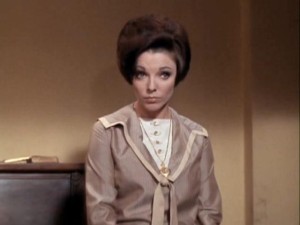
Edith runs a mission-slash-soup kitchen and clues in right away to the fact that Kirk and Spock, who greet her in stolen clothes after breaking into the basement of her mission, are hilariously out of place. But she still offers them a meal, a job, and a place to sleep, because Edith Keeler, despite her somewhat confused motivations and sadly absent backstory, is a Good Person who just wants to help people. She’s also a futurist, predicting the advent of atomic power and space travel. She’s a woman out of time, just like our stranded away team. And because the universe, no matter the timeline, wants James Kirk to be forever alone, he falls head over heels for Edith Keeler.
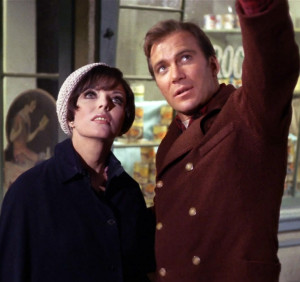
Yeah, you can guess where this is going.
Naturally, it turns out that Edith Keeler is the crucial focal point to which they’ve been drawn: in the new timeline, created by Bones’ interference, Edith sparks a peace movement that, uh, lets the Nazis win World War 2. In the original timeline, Edith dies in a traffic accident. Because it’s hard to argue with “okay but if she lives the Nazis win,” the obvious conclusion, as Spock says to Kirk, is that “Edith Keeler must die.”
…which, incidentally, is the best band name we have ever heard in our lives.
This is often hailed as the best episode of Star Trek. We don’t necessarily agree with that, though it does leave a powerful impression that is both sad and hopeful, and difficult to explain. In fact, it necessitated an after-hours two-hosts-of-three (sorry, Kim!) addendum, because we just couldn’t stop talking about it.
…or humming the Littlest Hobo theme song, embedded below for your edification if you’re not Canadian and have no idea what we’re talking about.
Podcast: Play in new window | Download | Embed
Subscribe: Apple Podcasts | Email | RSS
Ari
March 23, 2016
Episode 27 – TOS 1×27: “The Alternative Factor”
So this is one of those times where “hot mess” doesn’t quite do the episode justice.
The Enterprise is minding her own business, doing a boring, run-of-the-mill planetary survey, when all of a sudden, existence blinks. Literally, the entire universe seems to shiver and shudder and very briefly stop existing. How they, or Starfleet, which immediately dials them up to go “WTF!”, detect this precisely is a mystery best left to the annals of TV history. Maybe a Reality Integrity Detector is standard equipment for the farfaring starship?
Down on the aforementioned boring planet, there is suddenly a lifesign where once there was none. The crew investigates, and discovers Lazarus, who claims his enemy, who pursued him here and then attacked him, is out to destroy reality, and he needs the Enterprise’s help to stop him.

In Trek’s first foray into alternate universes, nobody can seem to decide how anything works. It’s like four different plots all crammed into one episode, at least half of them contradicting the other half. What people know and when and why they care about it is equally unclear; Lazarus, who turns out to have an alternate-universe doppelganger, switches identities so often that I stopped caring about keeping track. More than a quarter of the episode is taken up by our dimension-hopping guest star having body-switching fits up against bulkheads while the picture flares to negative-zone in the strangest TOS effects choice we’ve seen so far. And that’s all without even addressing the utterly baffling and consistently inconsistent take on how alternate universes work.
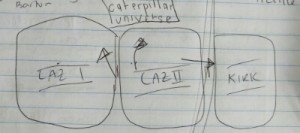
One bright spot (the biggest bright spot, who are we kidding) is the debut – and sadly, only appearance – of Lieutenant Charlene Masters (played by Janet MacLachlan, who had a guest role in basically every TV show made between 1965 and 1985), engineer, who steals every scene she’s in by being amazing and competent and simply does not have time for this alternate-universe-doppelganger nonsense.
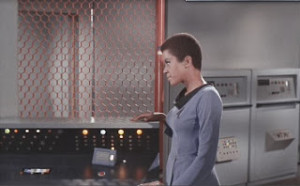
So this episode, kindly put, is crazypants. That’s not to say that as an artifact of sci-fi history, and Trek history, this isn’t interesting. There are a lot of threads that lead to later, more established Trek treatment of the whole alternate universe doubles trope, though I think it’s safe to say that later Trek, even later TOS, did a better job of keeping the many mechanisms of time-and-alternate-universe travel internally consistent. There’s a whole under-running theme here about positive v.s. negative universes that would be better ignored altogether. But this episode is high-stakes – the possible destruction of eternity, if Lazarus doesn’t succeed in stopping his double – and is resolved in one of our favourite ways: with Kirk and a guest star having a talk about science and thinking out the problem.
And then some hilarious wrestling. But what would an episode of classic Trek be without that?
Podcast: Play in new window | Download | Embed
Subscribe: Apple Podcasts | Email | RSS
Ari
March 16, 2016
Episode 26 – TOS 1×26: “Errand of Mercy”
So the chatter around this episode before we watched was basically KLINGONS KLINGONS KLINGONS. Because this week’s story involves the first appearance of our favourite (I know, we say that every time) Star Trek aliens: The Klingons!
…well, sort of. There’s a running joke regarding Original Klingons versus Classic Flavour Klingons, i.e. pre-Bumpy-Forehead v.s. Post-Bumpy-Forehead. Until the Enterprise storyline that tried (not super-gracefully) to explain away the drastically differing appearances of early and classic Klingons, the best explanation was basically “we do not discuss it.” Generally speaking this is the explanation we prefer, because early Klingons were… different. Warlike, sure. Super into military service, sure. Our favourite wine-swilling, wild-haired warrior poets?

…ehhhhh, not so much.
With war looming on the horizon, the Enterprise is dispatched to secure peaceful, pre-Warp Organia, a civilization that has stalled somewhere around Barely Medieval and just happens to be right in the path of the imminent Klingon invasion. Their planet is strategically valuable, and the Federation wants that planet secured for the protection of the rest of the region. Also, Klingons have a habit of enslaving and massacring their conquered subject worlds, which is something the Federation would like to avoid if at all possible.
Only one problem: the Organians don’t want the Federation’s protection. And then suddenly it’s too late: the Klingons have arrived, and the away team (only Kirk and Spock) are left stranded in the middle of an occupation.
You might describe this episode as a story about imperialism, and how even the benevolent kind of assimilation is Not Really That Great. That’s a valuable discussion to have, especially in Star Trek. Trek canon never stops talking about the fact that even though the Federation is, by and large, a benevolent force for good, the very mechanism of a society so large and powerful means that imperialism and assimilation, often explicitly denounced in Trek as negative, destructive things (that’s basically why the Prime Directive exists), are always waiting in the wings. A great example of this is the famous Root Beer Speech from DS9 (the important bit starts at at 1:35).
Two-thirds of us, though, were too caught up in the glaring, obvious fact that the supposedly helpless, primitive people the Enterprise was sent here to protect were secretly (SPOILER) all-powerful, non-corporeal ascended balls of light who were never in any danger, only took physical form to trick the actually-primitive visitors on both sides, and when the situation becomes genuinely inconvenient for them, snap their fingers and bend the Federation and Klingon forces to their will, declaring the war over. I mean, no war = good. But you might ask: “why take physical form in the first place?” They’re ascended! Beyond all mortal cares! All-powerful and all-knowing! And would they even have intervened if the Klingons and the Federation hadn’t shown up to play loud space-music on their front lawn? WHO KNOWS. (They definitely never interfere in galaxy-spanning space-war again, at least not in this reality, so I’m thinking… no.)
This incensed some of us (mainly me), and it took us a while to realize why this sort of high-handed behaviour felt so familarly infuriating. And then we remembered: the ascended jerks from Stargate.
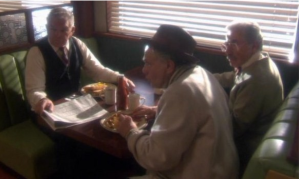
Ascended Omnipotent Aliens: dicks in every galaxy.
Podcast: Play in new window | Download | Embed
Subscribe: Apple Podcasts | Email | RSS
Ari
March 9, 2016
Episode 25 – TOS 1×25: “The Devil in the Dark”
So here are some things I have learned about mines from a lifetime of sci-fi and murder mystery consumption:
- stay out of mines; mines are trouble
- if you have to go into a mine, use the buddy system
- if you lose sight of your buddy, return to the surface immediately
- if you hear weird noises not easily explained by normal mine-type activities, return to the surface immediately
- if you have lost sight of your buddy, are hearing weird noises and a bunch of people have disappeared in or near this mine really, really recently? return to the surface immediately, at a dead run if at all possible; forswear all mines (and caves) forever
- see #1
In this episode, apparently nobody knows about the Cardinal Rules of Mines, because we open with a bunch of space miners ignoring every last one of them. Apparently some kind of monster has been killing (taking?) miners – 50 of them, as we join our not-long-for-this-world space miners – but they still definitely think it’s a good idea to leave one guy to guard the mining equipment armed with nothing but a class 1 phaser which in previous encounters has done precisely nothing against the mine-monster, the titular devil in the dark. Apparently the miners are banking on the imminent arrival of the Enterprise to save them and their mine, but sadly, help will not arrive in time to save poor, poor Sorry-Dude-But-Somebody-Has-to-Stand-Guard, who we see bite it in the first minute and a half of the cold open.
Of course, even our brave crew don’t have much luck with the monster at first – in fact, Kirk & Co don’t even seem to believe the monster exists! Which seems a little strange, given the 50 missing-probably-dead miners, but idk, maybe running off with a duffel bag full of space minerals is a real problem in 23rd century mines. Instead, what our good captain and his first officer first do is stand around, look skeptical, and fondle the mysterious, geological oddity the chief miner has displayed, totally inconspicuously, on his desk – a smooth, perfectly spherical, pure silicone ball – apparently the new level they just reached with their machines is full of them. And yes, this episode is equally full of ball jokes. Sorrynotsorry.
The above absurdity aside, this is actually a really great, classic episode of Star Trek. It’s a logic puzzle, really,where our heroes have to figure out what the monster is, what precipitated the sudden attacks after decades of incident-free mining, and why the monster – the Horta – was suddenly driven to kill. Because don’t be fooled: this is not a monster-of-the-week story. To stop the killing, Kirk, Spock and Bones have to step outside of their established body of knowledge, and solve a problem so alien and new that neither their usual problem-solving methods nor their highly advanced equipment can fully prepare them for it, or really help them. To win the day, our heroes have to totally re-think the definition of “life” as they know it. This episode gives us a situation where human beings (and half-Human beings, in the case of Spock) must grow and learn and depend upon the better angels of their natures in order to survive.
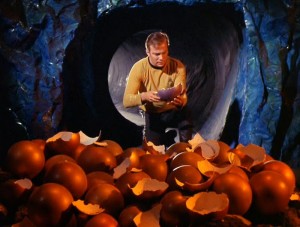
Suspend your disbelief and accept the hilarious 60s effects and the moments of extreme, committed scenery-chewing, and this story delivers a genuinely effective message: that life, and sentience, and intelligence, and people, in the purest sense, don’t always look like us, or anything you might expect, and that is not a requirement for someone to deserve your compassion, or your respect.
“If you can learn to feel for a Horta,” said Gene Roddenberry, about one of the most popular episodes of the Original Series, “you may also be learning to understand and feel for other Humans of different colors, ways, and beliefs.” And if that’s not the very essence of Star Trek, I don’t know what is.
Podcast: Play in new window | Download | Embed
Subscribe: Apple Podcasts | Email | RSS
Ari
March 2, 2016
Episode 24 – TOS 1×24: “This Side of Paradise”
In this week’s episode, the Enterprise crew is dispatched to investigate the fate of the worst summer camp of all time.
Technically they’re trying to establish the fate of the probably-lost colony of Omicron Ceti III – “lost” because after the colonists had already departed, Earth scientists discovered that the planet was under constant bombardment by deadly radiation that not only kills within a week but disintegrates unprotected organic tissue. (I mean, “lethal disintegrating radiation” would definitely be in the “must verify” Cons column in my Should We Colonize This Planet Pros/Cons checklist, but what do I know, I have an English degree.) The Enterprise arrives expecting to find no trace of the sadly-dead colonists, but then beam down to discover that… uh, they’re definitely all alive. Somehow.
Hey there, say the colonists. Sorry we haven’t called, but our space radio was busted, and we were busy founding a collectivist space farm commune on this perfect, perfect, perfect, perfect planet!
Fortunately this is one of those times where our heroes look at each other and say “hey, that’s weird,” and they keep asking reasonably pertinent questions, like a) what happened to all of your farm animals? and b) why are you all so eerily content? And actively attempting to solve the mystery.
Also present among the colonists is a woman from Spock’s past, botanist Dr. Leila Kalomi, who had a Thing for Spock that, by all evidence, he either did not, or could not, reciprocate. Leila is delighted to see Spock again, and equally delighted to answer all of his questions about how the hell they’re all still alive. The answer, amazingly, is flowers – flowers that, uh, well, there’s no other way to say it: ejaculate into people’s faces the moment they get close enough.
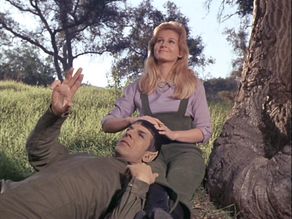
Leila exposes Spock deliberately, hoping to convince him to stay with them and, specifically, with her – and is upset when the affect of the isn’t as painless for half-Vulcan Spock as it was for the purely-Human colonists. He comes out the other side, though, as One of Them – because the flowers’ spores not only protect the colonists from radiation, but also create a kind of psychic groupthink that suffuses everyone with an overwhelming sense of perfect happiness and serenity, which doesn’t sound so bad until you substitute “serenity” with “total social stasis and possible mind control.”
Weirder still, under the influence of the flowers Spock is happy, for the first time in his life, which Nimoy portrays in a way that is somehow both gratifying (because even by whatever definition you want to use for a half-Vulcan, Spock is not, generally, a very “happy” man) and deeply, deeply unsettling (because flower-high Spock is disarmingly, heart-breakingly happy). Especially once he joins the colonists in their mission to convert the entire Enterprise crew.
Kirk saves the day by virtue of his immunity to happiness, but we’re left with some pretty troubling questions, like is happiness, imposed from without, really happiness? And is it better to be content but never change, or to change and grow at the expense of perfect serenity? And is paradise, by those descriptors, something anyone really wants?
Podcast: Play in new window | Download | Embed
Subscribe: Apple Podcasts | Email | RSS
Ari
February 24, 2016
Episode 23 – TOS 1×23: “A Taste of Armageddon”
This week’s episode is best described as a game of RISK that got massively out of hand.
Our fair ship is ordered (against the better judgement of literally every member of the crew, it seems) into a region of space with a galactic-standard Do Not Enter sign hung on the door. These orders are issued by Federation Ambassador Fox, AKA: The Beigest Man Alive, who probably should look into another career because he is actually not very good at diplomacy. Kirk protests that going in there is a) a bad idea and b) could totally start a war, but Fox insists, and in they go.
Guess what happens.
Not only is the Enterprise crew instantly sentenced to death the moment the away party beams down, but it gets crazier: this planet has been engaged in a 500-year-long war with a neighbouring world where casualties are caused not by bombs and guns, but calculated by computer – at which point the unfortunate victims of mathematics walk willingly into a disintegration machine. We kill 3.1 million of ourselves every year in this war, say their extremely solicitous hosts! It’s no big deal!
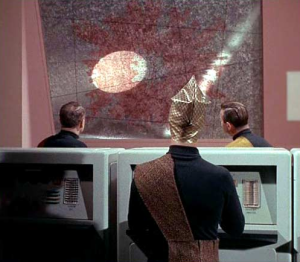
As you might imagine, Kirk & Co. object in the strongest possible terms.
This episode also features guest star Barbara Babcock, who went on to join the secondary cast of Doctor Quinn, Medicine Woman, which you’ll know because of the 2.5 minute micro-lecture at about minute 26. It also also contains the second appearance of Yeoman Tamura (played by Miko Mayama, first seen in Court Martial), who is highly competent and wishes she got to point alien space-crystal-rayguns at people more often.

The consensus is that this episode was and remains relevant to the way we, in the West, view distant wars. In 1967, this was a thinly-veiled metaphor for Vietnam conscription and the Television War – in 2016, it’s a commentary on drones and our ability to kill real fellow humans from thousands of miles away using what is basically an Xbox controller. Eerily lifelike, and sufficiently chilling that despite the usual massive plotholes and inexplicable decision-making, I think this one holds up.
Editor’s Note: There’s a point where I suggest this episode contains callbacks to the movie Logan’s Run, before Kim reminds me that Logan’s Run the movie came out in 1976, and A Taste of Armageddon hit TV screens in February 1967. Logan’s Run the book was published in 1967, but I couldn’t find a specific date. Who knows? But if the two were unrelated it’s a hell of a co-incidence. (tl;dr: watch Logan’s Run. Sci-fi classic. Scary. Very Good.)
Podcast: Play in new window | Download | Embed
Subscribe: Apple Podcasts | Email | RSS
Ari
February 17, 2016
Episode 22 – TOS 1×22: “Space Seed”
This week’s episode is arguably the most famous episode of The Original Series – or at least, introduces one of the most famous-in-the-mainstream (and most controversially-rebooted) villains of Star Trek.
That’s right. You know who I mean.
KHAAAAAAAAAAAAAAAAN!
In Space Seed, the Enterprise encounters the Botany Bay, an ancient apparent derelict drifting far beyond where a ship of that era should have been able to safely reach. Stranger still, there are lifesigns aboard. When they investigate, the crew discovers 72 people in stasis… who are definitely may or may not be a missing group of despotic, empire-mad, genetically-engineered superhumans (who in later canon became known as the Augments) who disappeared at the end of Earth’s Eugenics Wars. Their leader is Khan Noonien Singh, portrayed by the incomparable (especially as concerns gangly, ultra-white English actors in reboots better left undiscussed) Ricardo Montalban.
One of the most confusing and inconsistently-covered periods in Star Trek canon history, the Eugenics Wars are first introduced in this episode and never, through four series and close to a dozen movies, satisfactorily explained. But you know we love us some fictional future Earth history, even if it’s full of holes big enough for a Constitution-class starship.
We have our doubts about Khan’s suitability as Kirk’s Greatest Nemesis (mainly due to his and the other Augments’ general incompetence at starship conquest in this and later outings), as well as his much-touted magnetism, but you can’t deny watching Khan chew scenery is entertaining, even if the writers fell back on some pretty backwards romantic constructs when formulating the relationship between Khan and poor, under-written Marla McGivers. Let’s just say that these ladies of the future prefer our men minus the god complex.
Podcast: Play in new window | Download | Embed
Subscribe: Apple Podcasts | Email | RSS
Ari
February 10, 2016
Episode 21a – Bonus Content: Bryan Fuller Announced as New Trek Series Showrunner
Yesterday the news hit the Interwebs that we finally have a showrunner for the up-and-coming new Trek series: Bryan Fuller, probably best-known, at the moment, for recently-concluded series Hannibal. His other credits (in addition to some way-back-when episodes of Voyager and Deep Space Nine that officially qualify him as a Trek Alum) include the ultra-whimsical and cult-beloved Pushing Daisies and Wonderfalls.
Editor’s disclaimer: Most of Fuller’s existing oeuvre is, as they say, Not In My Wheelhouse (in that I am turned off by greater than trace-level whimsy and actively freaked out by Hannibal). That, plus my “committed pessimism until proven otherwise (because then I can’t be disappointed)” policy re: new Trek, means that the nicest word I can use to describe my feelings about this news is “ambivalence.”
HOWEVER: Bryan Fuller is VERY EXCITED ABOUT STAR TREK, so while I refuse to feel the human emotion of hope about Star Trek ever again, I will grant that that this news is already a step up from the last attempt in the franchise. Kim and Corene are SUPER-EXCITED about this news, so you should definitely ignore this summary and listen to them enthuse. Kim (enthusiastic Hannibal fan) was, at the time of this recording, visibly vibrating with joy.
Podcast: Play in new window | Download | Embed
Subscribe: Apple Podcasts | Email | RSS
Ari
February 10, 2016
Episode 21 – TOS 1×21: “The Return of the Archons”
If you’ve ever heard fellow geeks make “of the body” jokes, this is where it comes from. In this episode, the Enterprise is out to solve the mystery of the disappearance of the U.S.S. Archon, which apparently crashed on unexplored Beta 3 – a planet so far away from Earth that it’s taken a century for someone to come looking for them. But instead of the hale and happy descendants of the Archon crew, they beam down to discover to whole planet of old-timey, ultra-polite zombies… and they really want the Enterprise to join in.
This episode is bursting at the seams with amazing early references to stuff that later becomes central the the Star Trek mythos, and asks a lot of really interesting questions, many of which are still relevant today! As a result we spend a lot of time talking about quasi-serious-business Star Trek analogies for real-life history & society this week, including but not limited to: Cold War terrors of communism as an all-consuming, individuality-crushing machine (as a bonus, spot the possible early seeds of the Borg!); herd immunity and the concept of society as body; the nature of human sentience, in an age where we are beginning to seriously discuss the preservation of human consciousness in digital storage; and What Is Consent, Anyway, when you’re being wholly controlled by an evil god and unable to voice an opinion or make a decision? (spoiler: It Isn’t).
There’s also a lot of really interesting, if subtle, in-episode talk about how mythology is perpetuated through a society in the form of a spaceship crash creating a prophecy that accurately predicts the Enterprise’s arrival. Also first seen in this episode: a genuine mention and micro-discussion of the Prime Directive… which of course Kirk & Co. proceed to completely ignore in favour of talking a computer to death.
All good fun.
***
Kim guest-hosted on another podcast this week! Check out the ThumpaThumpa podcast to hear her talk about Queer As Folk. You can find them on Tumblr and Podbean.
Podcast: Play in new window | Download | Embed
Subscribe: Apple Podcasts | Email | RSS
Ari
February 3, 2016
Episode 20 – TOS 1×20: “Court Martial”
In the Space Justice System, the Space people are represented by two separate, yet equally important Space groups: the Space officers who commit the Space Crimes, and the Space attorneys who Space prosecute the Space offenders.
These are their stories.
CHUNG CHUNG
That’s right, it’s Law and Order, ST: TOS!
In this episode, Kirk is in trouuuuble. During a recent crisis, he ejected a mumblemumbleplot pod to save the ship. Sounds fine, right? Except the pod contained a guy with whom he had some seriously rocky history (and who’s been holding one hell of a grudge against Kirk), raising concerns that James T. Kirk, of all people, might have chosen to deliberately eject said pod in order to get the angry jerk out of his face. And worse: the computer records say that Kirk is lying about what happened. Cue a court martial, aka: Space Court Room Drama, which comprises about 75% of this story.
Now, I want to be up front here about the fact that this episode contains what we will call a multitude of holes. There are, for instance, better ways to get revenge on someone than elaborately framing them for your murder (because SPOILER: angry jerk isn’t dead! the whole thing was a set-up!). There are also tidier ways of framing people for murder. Agatha Christie, this man is not. Some of the arguments made in the court martial are, let us say: facile. We could also call them: stupid. Also, the crucial central evidence that was supposedly falsely created by the computer due to some kind of *handwave* tinkering? I lost count of how many times I yelled “COMPUTERS DON’T WORK LIKE THAT.”
All that aside, though, 2/3 of your hosts really like this one. Everyone is working really hard. There are some excellent guest stars in the form of Kirk’s defense advocate and the prosecutor, who is an old flame of Kirk’s but is not a) played by a 19-year-old girl or b) swayed by him in any way, shape or form, despite being visibly very fond of him. There’s even some (fundamentally stupid and wrong but whatever) narratively clever detective work by Kirk’s crew, who are basically NOPE about this whole “the captain murdered somebody for petty revenge” thing. It’s also set on a Starbase, which is always a joy: show us more futuristic pseudo-cities!
It turns out all right, with the angry jerk being caught, Kirk being exonerated, and the Enterprise warping off on her merry way. If you like Law and Order or half-baked but very enthusiastic murder mysteries, this episode’s for you.
Podcast: Play in new window | Download | Embed
Subscribe: Apple Podcasts | Email | RSS